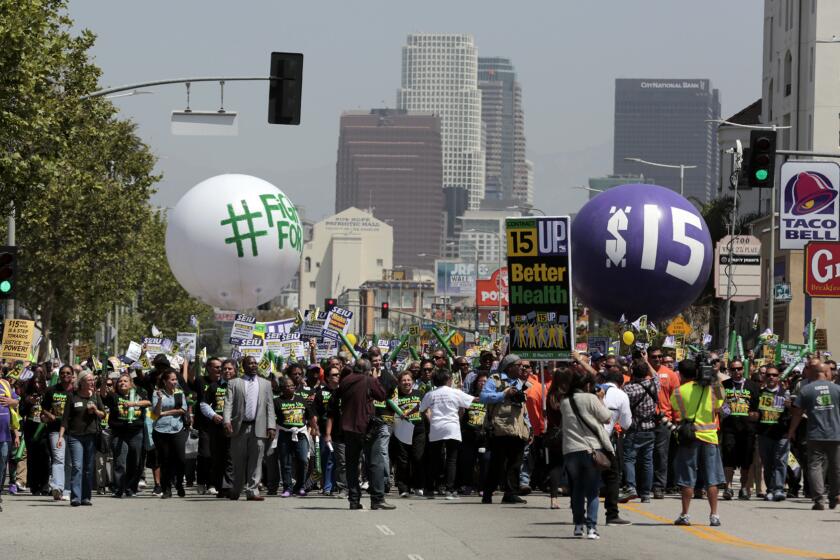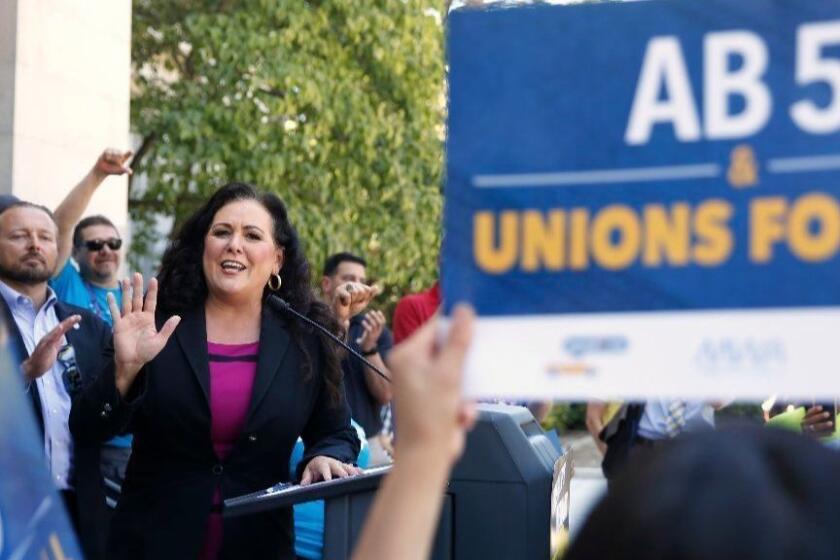Column: The key to union resurgence is repeal of the Taft-Hartley Act
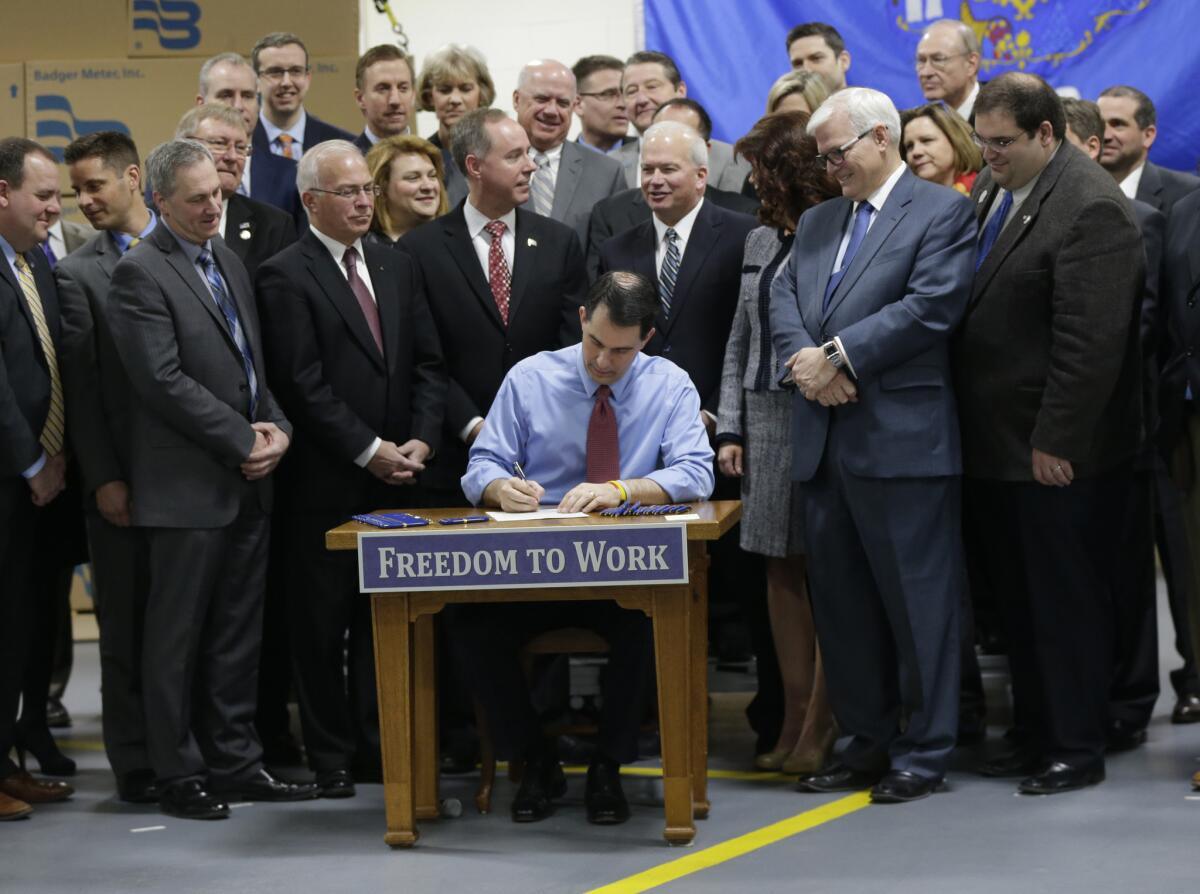
- Share via
Labor advocates and critics alike can debate the reasons for the decline of union membership in America over the last seven decades, but one event gets the nod from both sides as a major obstacle to union organizing. It’s the passage in 1947 of the Taft-Hartley Act.
“Taft-Hartley was devastating to labor,” the former (and reformed) union-buster Martin Jay Levitt wrote in 1993. In labor relations, he observed, management always had the upper hand. But after Taft-Hartley, “the bosses could once again wage their war with near impunity.”
So it’s understandable that the two most progressive candidates running for the Democratic nomination for president, Sens. Bernie Sanders of Vermont and Elizabeth Warren of Massachusetts, have called for repeal of sections of the act.
Taft-Hartley led to the ‘union-busting’ that started in the 1960s.
— Labor lawyer Thomas Geoghegan
But have they gone far enough? Veteran union strategist Rich Yeselson thinks not. Instead of piecemeal revision or repeal of some provisions of Taft-Hartley, he says, “why not just shoot the moon: Get rid of this awful law!”
Taft-Hartley was the product of three threads in American politics of the late ‘40s that became braided together. One was the red scare, which became directed at unions such as the CIO that had relied on communist organizers to do unionizing work on factory floors.
Another was the burgeoning influence of corporate managements, especially after Republicans took over the House and Senate in 1946, the first time the party controlled both chambers of Congress in 18 years.
Elizabeth Warren’s labor proposals would reverse years of government hostility and indifference to workers.
The third was a public backlash to a wave of postwar strikes, including a general strike in Oakland in December 1946. The Oakland strike was an “almost unprecedented demonstration of worker power,” labor historian Erik Loomis has written.
But it also raised the hackles of voters in regions where union representation was not strong — such as outside the industrial heartland and Northeast. An estimated 14% of all workers had participated in postwar strikes, which made the wave of labor unrest appear to be virtually universal.
Even liberal Democrats weren’t above riding the anti-union wave. One was Lyndon Johnson, who attacked Coke Stevenson, his opponent in his 1948 campaign for the Senate, for being beholden to unions — while he himself “courted CIO support behind the scenes,” Loomis noted.
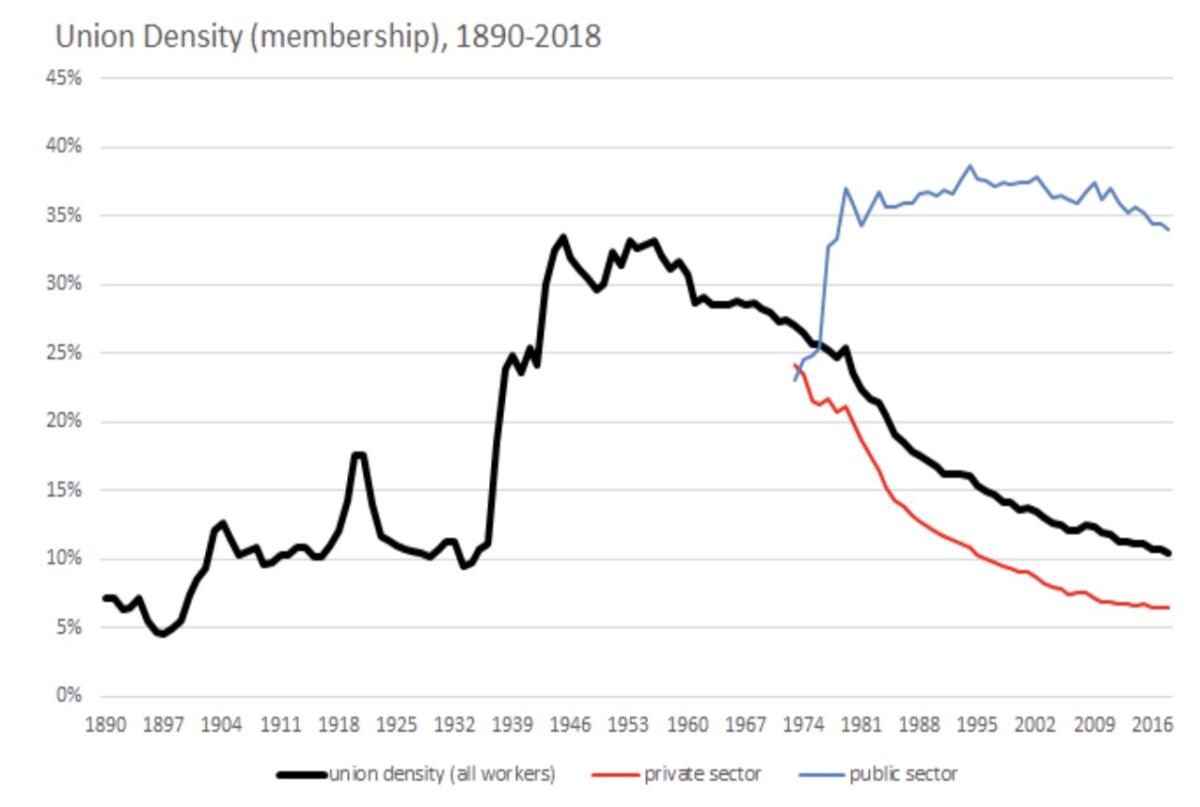
Harry Truman vetoed the Taft-Hartley Act, but as a Democratic President he was outgunned. Congress overrode his veto with large margins, and the fate of the union movement was sealed.
It’s certainly true that union leaders deserve some of the blame for the long-term decline of organized labor, as do fundamental changes in the nature of work and employment in the U.S. over the last 70 years. But Taft-Hartley set the groundwork for that decline in myriad ways.
Freelance writers and photographers fear California’s new gig worker law will make them unemployable.
After Ronald Reagan scored his victory over the Professional Air Traffic Controllers Organization, or PATCO, by firing its striking members in 1981, employers followed his lead by instituting an era of unexampled hostility to organized labor. Taft-Hartley provided them with the playbook.
“Taft-Hartley led to the ‘union-busting’ that started in the 1960s,” labor lawyer Thomas Geoghegan wrote in this 1991 book, “Which Side Are You On? Trying to Be for Labor When It’s Flat on Its Back.” In its wake, “a new ‘profession’ of labor consultants began to convince employers that they could violate the Wagner Act [the National Labor Relations Act of 1935], fire workers at will, fire them deliberately for exercising their legal rights, and nothing would happen.” (Emphasis his.)
Let’s see how this worked.
The best-known provision of Taft-Hartley may be its section 14(b), which allows states to enact “right-to-work” laws that prohibit contracts requiring union membership as a condition of employment. Right-to-work laws have been enthusiastically embraced by 27 states, including the entire Southeast.
Pro-business groups such as the U.S. Chamber of Commerce praise these laws as fostering higher job growth and personal income than in states without them; studies by labor-friendly organizations assert that average wages and benefits are lower in those states. Evidence from both camps does suggest, in any case, that right-to-work states generally had lower rates of union membership even before their enactment, and faster declines in membership afterwards.
The limits of the trend to more right-to-work legislation may have been reached, however. Missouri voters overwhelmingly rejected a right-to-work law at the polls last year.
The spread of right-to-work laws led to the emergence of the free-rider problem, in which nonunion members benefit greatly from union contract negotiations and enforcement of contract provisions, but don’t have to pay dues to support that work. The National Right to Work Committee, a leading promoter of these laws, has ties to the Koch network, though it describes itself as “a coalition of 2.8 million workers, small business owners and freedom-loving Americans.”
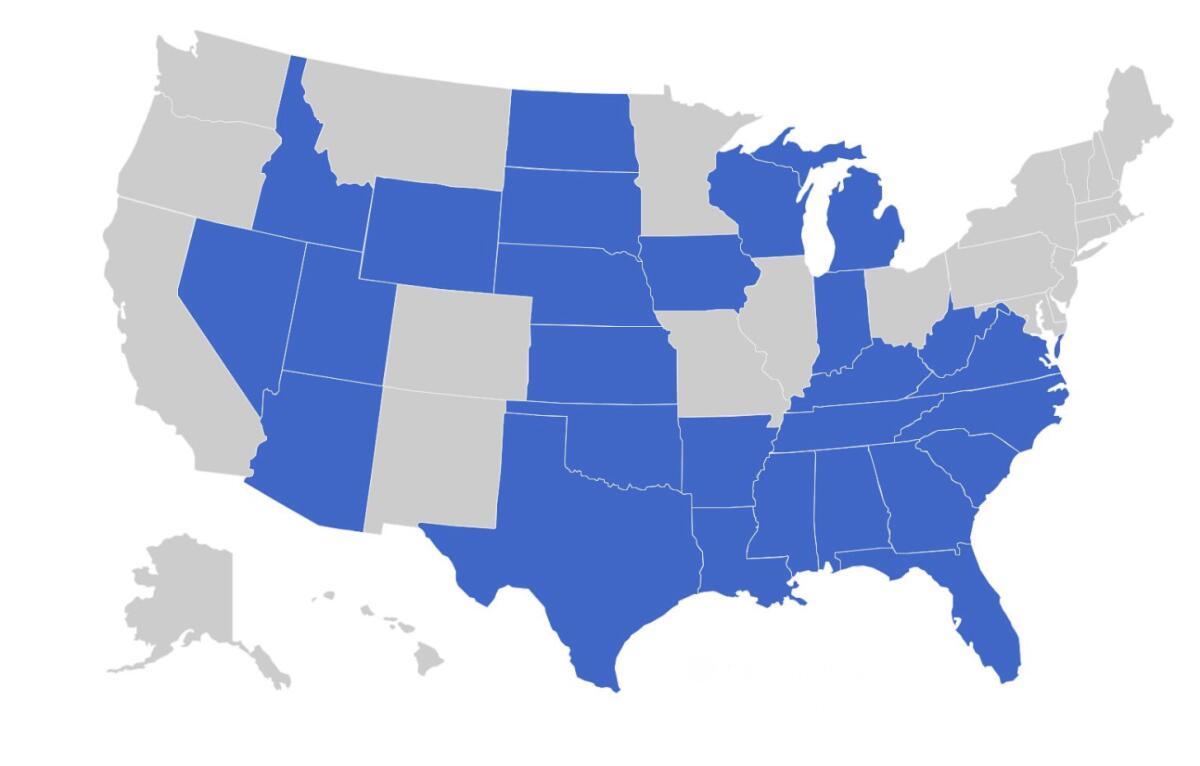
Other provisions of Taft-Hartley are equally damaging to unionization efforts. It prohibited mass picketing, sit-down strikes and (more vaguely) secondary boycotts, in which unions take aim at suppliers or customers of their primary target.
The law allowed employers to stage “captive meetings,” mandatory gatherings in which they plied their employees with anti-union propaganda. The National Labor Relations Board in 1946 had barred such meetings on the grounds the economic dependence of the workers on their bosses made them inherently coercive and therefore an unfair labor practice by their very nature. Taft-Hartley overturned the NLRB ruling and awarded managements a so-called free speech exemption that vastly improved their chances of prevailing in union elections.
Taft-Hartley also significantly complicated the process of certifying unions as representatives of workers. Previously, the NLRB could certify a union if a majority of workers signed authorization cards, a provision known as “card check.” The law wiped out card checks, substituting a process that, as Geoghegan wrote, required “hearings, campaign periods, secret-ballot elections, and sometimes more hearings, before a union could be recognized.” Organized labor has lobbied for the restoration of card check for years, including via the proposed Employee Free Choice Act, but without success.
The law also tightened the definition of “supervisor,” removing the eligibility for unionization from a sizable and influential cadre of workers. “Corporate managers and their allies in Congress viewed an alliance of unionized workers with unionized supervisors as ... a grave challenge,” Yeselson observes. Taft-Hartley nullifed the challenge. The law also defined independent contractors as non-employees and therefore ineligible to join unions, setting up a conflict that has mushroomed into the gig-worker vs. employees controversies of today.
Uber, Lyft and Doordash will spend $90 million to undercut a California employment law.
Sanders and Warren, to be fair, have turned their sights on repealing the most noxious provisions of Taft-Hartley. Both are in favor of restoring the card check process. Both favor outlawing right-to-work laws and “captive audience” meetings staged by management. They endorse restoring the right to secondary boycotts, although as Yeselson reports, the prohibition in Taft-Hartley is murky enough to have allowed at least some union activities that might be considered to fall within the definition.
Both also call for addressing the Taft-Hartley restriction on unionization of supervisors, although Yeselson criticizes Warren for merely advocating a limitation on the definition, a step he argues would perpetuate battles over who is or isn’t a supervisor that complicates organizing efforts.
But both candidates arguably have missed a bet by focusing on these provisions as though they exist in individual silos, rather than being part and parcel of the most far-reaching attack on unions ever staged by Congress. It’s important for the candidates to lay out the particulars of their pro-labor platforms, but it might also be easier to wrap them all together in a single theme: For the health and livelihoods of rank-and-file workers from coast to coast, the goal should be to wipe the entire Taft-Hartley Act off the face of the Earth. By the way, every single Democratic candidate for president should sign the pledge.
More to Read
Inside the business of entertainment
The Wide Shot brings you news, analysis and insights on everything from streaming wars to production — and what it all means for the future.
You may occasionally receive promotional content from the Los Angeles Times.

